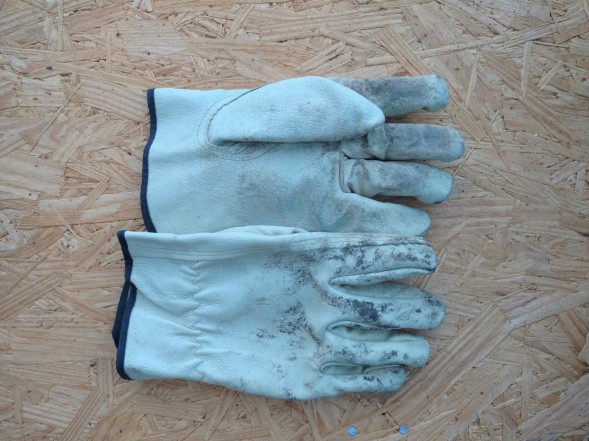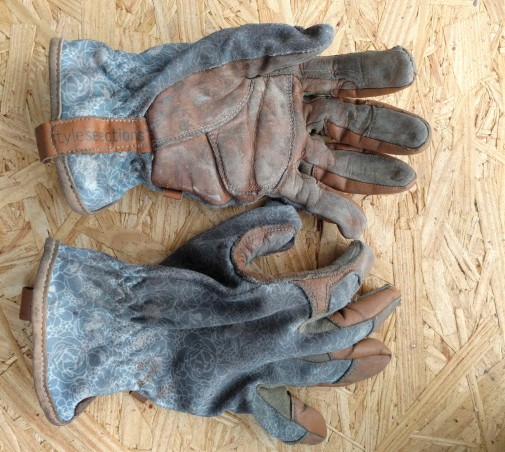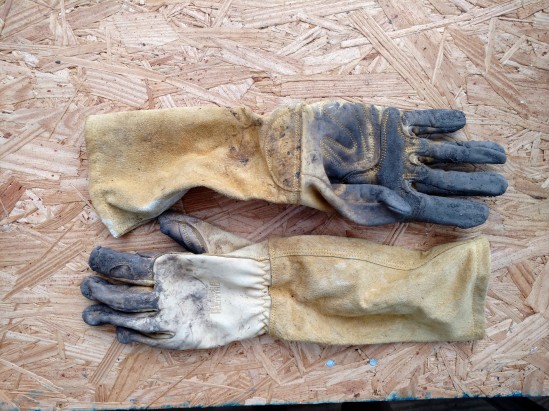In the past few years, I’ve blasted through too many pairs of gloves. I use them for a combination of building (holding splintery wood) and gardening (digging, weeding), and I’ve come to really value a good glove. That said, some projects are fine for cheapos.
You can pick up gloves every where from dollar stores to Etsy. Most of mine have come in the form of gifts or last-minute purchases at a home improvement store. I actually hate buying gloves because so many pairs have let me down.
Sometimes gloves can feel like a waste of money, but if you do any kind of work with wood, stone, concrete, dirt, or plants, you really need to protect your hands. Gloves don’t just keep your nails clean; they’ll shield you from splinters, spiders, and other nasties hiding in your project. And if your yard is like mine, they’ll also protect you from a seemingly endless supply of broken glass in the ground (it’s like my yard used to be a dumping ground for old windows. Sheesh!).
Below are the gloves I have in my current rotation, cheapest to most expensive. After that, I’ll go over the things to look for in a good gardening gloves.
The Cheap Glove

If I’m totally honest, I don’t remember how much I paid for these gloves because don’t remember where I bought them (possibly Big Lots?). They’re thin leather, which is pretty good for durability. However, despite some use, they’re pretty stiff and not at all tailored to my hands. The bulky/stuff fingers make fine work difficult.
They aren’t padded enough to be good for rub prevention (like in using a shovel). I mostly use these for light-duty work where I just need so type of barrier between my hands and the object – carrying a few concrete blocks, dragging downed tree limbs, etc. As these were cheap (or maybe free), they are also my go-to gloves for messy work, like mucking out the chicken coop.
The Mid-Grade Workhorse

After my last everyday pair of gloves suffered blowouts in the fingertips, I sprung for a slightly more expensive pair at Lowes. You can find them here.
These actually fit me and the fingers have a lot of flex, so I use them for the majority of my work in the garden. The leather on the palms and fingers adds some durability and a little bit of padding, so they’re also what I use when handling tools and rough material that requires dexterity.
The Specialized Glove

I received these last year for Christmas. They have the totally awesome name of “gauntlet gloves,” so I feel a bit like a knight when wearing them. They’re made of “supple goat leather,” so they were super soft and flexible right out of the bag. These gloves are so nice that I was reluctant to use them for a long time (though you can see I’ve clearly gotten over that).
The main downside to these is they still turn my hands and lower arms kiiiinda orange. Also, I can’t really use these during the summer because that leather just traps the heat in my arms. However, they are really nice for clearing out dense patches of weeds or dealing with bushes – anything that might otherwise scratch up my arms. Truth to told, I wouldn’t have bought these for myself, but I’m glad to have them.
What to Look for in a Glove
Of course, different tasks have different requirements, but in the list below, I’m thinking about one glove that would suit a multitude of applications.
Leather
It’s what all three pairs of my gloves share. I’ve had many, many gloves, and I don’t toss things until they’re destroyed. My canvas gloves and nitrile-dipped gloves have all experienced blowouts in the fingers. Leather is the reason the gloves in my list above have stuck around. At a minimum, you’ll want your palms, fingers, and fingertips covered. I haven’t tested any faux leather gloves, so I’m not sure how those hold up.
Breath-ability
My all-leather gloves tend to make my hands sweaty. Although leather breathes, it doesn’t do so as well as other materials. That’s why I like the cotton backs of my workhorse gloves. One downside of those, though, is the thinner material is a weak point and also an area where wetness can get into the glove. Breath-ability in a glove is important not just for comfort, but also to prevent bacteria growth and to keep your hand from slipping around.
Fit
Again, fit is where having those partially cotton gloves comes in handy. I find that it’s more difficult to get a close fit on all-leather gloves because the material is thicker. However, a more expensive pair of all-leather gloves made of more supple leather might be able to achieve the same result. Also look for some elastic or a strap around the wrist area so the gloves don’t fly off when you’re shooing chickens out of the garden.
Padding
If this is a glove you’re using for both building and gardening, you’ll want at least a little bit of padding to prevent blisters. At a minimum, look for padding along the base of your fingers and thumb. If you don’t need much, a double-layer of leather might do the job. If you’re planning on using these gloves for a lot of digging, tilling, etc., look for ones designed specifically with padded areas.
What I Won’t Buy
(for my own regular use, anyway)
Canvas
Canvas is attractive because it’s inexpensive, free of animal products, and seems sturdy. However, I’ve quickly ripped through almost any canvas glove I’ve ever bought. They get wet and slightly used, and suddenly they’re tearing like tissue paper.
Touchscreen Pads
Since the fingertips can be a weak point anyway, I want something super tough covering my fingers. That usually means they’ll be unwieldy to use in screen navigation. Besides, if I’m covered in dirt, I don’t really want to pull out my phone anyway. Touchscreen fingertip pads, in my opinion, are an unnecessary feature of a gardening glove.
Nitrile
Nitrile-dipped gloves grabbed my attention at first because, like canvas, they’re on the cheaper side and seem durable. However, I’ve found that they just don’t hold up for long. After a season coated in garden mud, my fingers poked through the nitrile. They also don’t hold up around sharp objects – nails, etc. – in construction. These are probably find for folks doing light gardening, but I need something tougher for a multi-use glove.
The Bottom Line:
A bad glove is at the very least a hassle and may give you blisters. However, choosing a poor glove may also result in more serious injury if the material isn’t enough to protect your hands from shards, splinters, and other hazards present in your yard or workspace.
I’ve found that good gloves start at around $20. As of this posting, my Mid-Grade Workhorse pair run $21.98. I’ve been using them all year and they’ll probably carry me through the winter, depending on what projects are in my future. For my next pair, I plan to shop around and spend up to $40. Hopefully I can find a pair locally!

